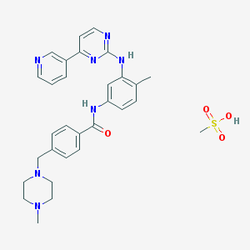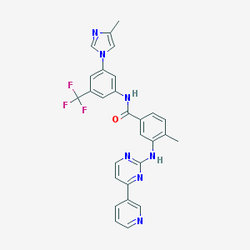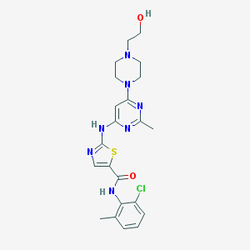This web page was produced as an assignment for Gen677 at UW-Madison Spring 2010
Chemical Genetics
Chemical genetics is used to find drugs that can be used to treat diseases and help in the research of the mechanisms of diseases.
DrugBank was used to determine current chemicals being used to treat CML. Each of these chemicals were analyzed used PubChem. The search resulted in 3 different chemicals.
DrugBank was used to determine current chemicals being used to treat CML. Each of these chemicals were analyzed used PubChem. The search resulted in 3 different chemicals.
Nilotinib is another TKI which inhibits the tyrosine kinase activity of the BCR-ABL protein and is used as an alternative to imatinib mesylate often to the acquired resistance to imatinib mesylate. Nilotinib overcomes resistance by binding with a higher affinity to the ATP-binding site of the BCR-ABL protein.
Dasatinib is another TKI which inhibits not only the tyrosine kinase of BCR-ABL but also the tyrosine kinases of the SRC family, one of the proteins ABL1 directly interacts with. The addition of inhibiting SRC allows it to overcome resisitance of imatinib mesylate. By binding to the tyrosine kinase, dasatinib inhibits cell growth of CML cell lines.
Analysis
The initial treatment of CML is primarily imatinib mesylate, but a growing problem is the increase of acquired resistance due to mutations or overexpression of the BCR-ABL protein. Overexpression of the BCR-ABL protein can be compensated by higher dosages, but mutations require the usage of other TKIs such as nilotinib and dasatinib. Other drugs such as bosutinib (dual Scr and ABL inhibitor), omacetaxine (a multitargeted protein synthase inhibitor), AP24534 (a multikinase inhibitor), Danusertib hydrochloride (aurora kinase inhibitor), and DCC-2036 (a switch pocket inhibitor which controls the state of the ABL activity) are under investigation as other possible treatments. (3)
References
1. DrugBank http://www.drugbank.ca/
2. PubChem http://pubchem.ncbi.nlm.nih.gov/
3. Fullmer, A., Kantarjian, H., Cortes, J., and Jabbour, E. (2011). New developments in the treatment of chronic myeloid leukemia and Philadelphia-positive acute lymphoblastic leukemia. Leukemia and Ly
2. PubChem http://pubchem.ncbi.nlm.nih.gov/
3. Fullmer, A., Kantarjian, H., Cortes, J., and Jabbour, E. (2011). New developments in the treatment of chronic myeloid leukemia and Philadelphia-positive acute lymphoblastic leukemia. Leukemia and Ly



